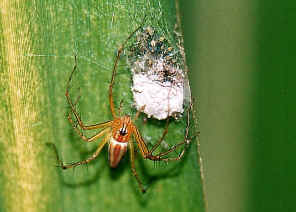Genus/species: Peucetia viridans
Order/family: Araneae: Oxyopidae
Table of Contents
Introduction:
Lynx Spiders are long legged spiders which can be easily identified by the very long spines on their legs and their eye setting. Their abdomen is like a pencil ending in a point. Their size is between 4 and 6 mm. The spiders are common in Brisbane gardens. They have very good vision, with eight eyes, in the pattern four rows of two. They come in many different colours, the Green Lynx spider is quite common in the United States. It is a conspicuous, large, bright green spider found on many kinds of shrublike plants throughout the southern United States and is the largest North American lynx spider and is common throughout Florida.


Bite:
While the Green Lynx spider aggressively attacks its insect prey, it very seldom bites humans. While its bite is of little concern to humans, the green Lynx spider is of interest because of its potential use in agricultural pest management. However, their usefulness in the control of insect pests is counteracted by their willingness to prey also upon beneficial insects. These spiders seize large numbers of honey bees, Apis mellifera Linnaeus, and sphecid and vespid wasps.
Habitat:
Lynx spiders are found all over the world including Australia and USA. The spiders are common in gardens and can be found in trees or on grass, usually on the top of the plants.
Prey:
They move actively in day time hunting small insects. They have a long body and long thin legs. The egs are covered with long spines. They are colourful with green-yellow, silver and brown bands along their bodies. They hunt like a cat, i.e., slowly approaching the prey and suddenly jumping on it and this where the spiders got the name “Lynx” from. Although their eyesight is not as good as that of the jumping spiders they can see their prey from a distance of up to 10 centimeters.
Breeding:
Female Lynx Spiders show great parental care, guarding her eggs and then two weeks later when the egg sac hatches , guarding her children. This is common in the spider world. Lynx Spiders do not build web nor retreat but make egg sac on leaves.
Click here for more photos of Lynx Spiders.
Information and pictures were taken from children’s projects and where credited to that child does not claim to be original information. Where possible, permission to reproduce has been sought. Any infringement of copyright is purely unintentional.
